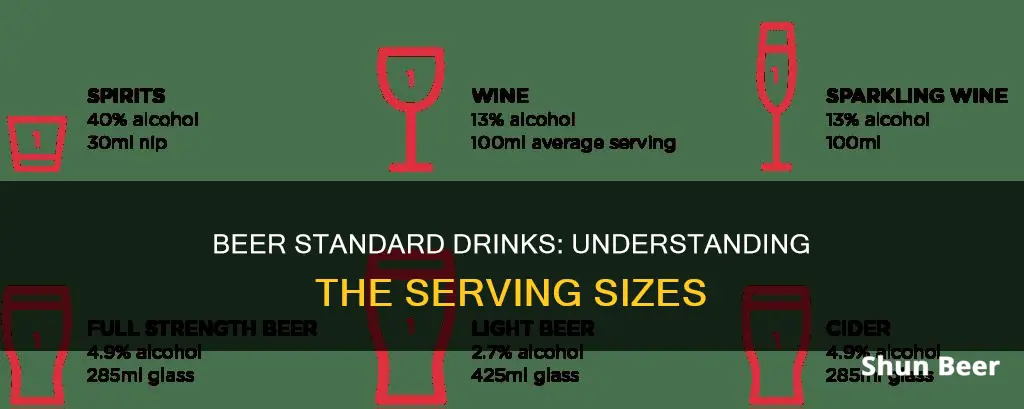
In the United States, a standard drink of beer is defined as a beverage containing 0.6 fluid ounces or 14 grams of pure alcohol. This is equivalent to 12 fluid ounces of beer with 5% alcohol. However, it's important to note that different types of beer can have varying alcohol content, with some craft beers containing up to 8%-10% alcohol or more. Additionally, the serving size of a beer may be more than one standard drink. For example, a pot of full-strength beer contains 1.1 standard drinks, while a 375ml stubby contains around 1.4 standard drinks. Understanding standard drink sizes can help individuals track their alcohol consumption and make informed decisions about their health and safety.
What You'll Learn
- A standard drink of beer is 12 fl oz with 5% alcohol content
- A standard drink of malt liquor is 8–10 fl oz with 7% alcohol content
- A standard drink of beer is about 0.6 fl oz or 14 g of pure alcohol
- A standard drink of beer is different from a serving, which may be 1.1-1.4 standard drinks
- A standard drink of beer is not the same as a 'single-serving' drink, which may be two or more standard drinks

A standard drink of beer is 12 fl oz with 5% alcohol content
In the United States, a "standard drink" of beer is defined as 12 fluid ounces with 5% alcohol content. This is often referred to as one alcoholic drink equivalent and contains roughly 14 grams or 0.6 fluid ounces of pure alcohol. It's important to note that the percentage of alcohol by volume (ABV) can vary across different beer types, and a standard drink may not always align with customary serving sizes.
The concept of a standard drink is particularly relevant when it comes to tracking alcohol consumption and understanding its impact on health. By defining a standard drink, individuals can more effectively monitor their intake and make informed decisions about their drinking habits. This is crucial as excessive alcohol consumption can have serious health consequences. Knowing the standard drink measurement allows for a consistent understanding of alcohol content across various beverages, helping individuals stay within recommended guidelines.
The standardisation of drink sizes is especially useful when comparing different types of alcoholic drinks, as they can contain varying amounts of alcohol. For example, a standard drink of beer (12 fl oz with 5% alcohol) will have a different alcohol content than a standard drink of wine (5 fl oz with 12% alcohol) or distilled spirits (1.5 fl oz with 40% alcohol). Understanding these differences is essential for responsible drinking and maintaining one's health.
While the definition of a standard drink provides a helpful guideline, it's worth noting that serving sizes may differ. Additionally, factors such as glass or container size, varying glass sizes at venues, and unknown alcohol quantities in mixed drinks can further complicate drink tracking. Therefore, it's always important to be mindful of these variables and refer to health guidelines and recommendations when making decisions about alcohol consumption.
Beer Drinking in Central Park: What's Allowed?
You may want to see also

A standard drink of malt liquor is 8–10 fl oz with 7% alcohol content
The amount of liquid in your glass, can, or bottle does not necessarily match how much alcohol is in your drink. Different types of beer, wine, or malt liquor can have very different alcohol content. For instance, regular beer typically has 5% alcohol content, while some light beers contain 4.2% alcohol. Thus, it is important to know the alcohol content of your drink.
In the United States, a "standard drink" or "alcoholic drink equivalent" contains roughly 0.6 fluid ounces or 14 grams of pure alcohol. This is equivalent to 12 fluid ounces of regular beer, which is usually about 5% alcohol. However, when it comes to malt liquor, a standard drink is typically defined as 8–10 fluid ounces with 7% alcohol content.
It is worth noting that the percentage of pure alcohol, expressed as alcohol by volume (alc/vol), can vary within and across beverage types. While these standard drink amounts are helpful for following health guidelines, they may not reflect customary serving sizes.
To put this into perspective, a standard drink of malt liquor with 7% alcohol content is approximately equivalent to:
- 12 fluid ounces of regular beer, which typically has 5% alcohol content.
- 5 fluid ounces of table wine, which usually contains 12% alcohol.
- 1.5 fluid ounces of distilled spirits, which equates to about 40% alcohol.
Understanding standard drink sizes is crucial for knowing how much alcohol you are consuming and making informed decisions about your health. These amounts can help you count and track your drinks, as excessive alcohol consumption can have serious health impacts.
RV Drinking Laws: Beer and Driving
You may want to see also

A standard drink of beer is about 0.6 fl oz or 14 g of pure alcohol
In the United States, a "standard drink" is defined as any beverage containing 0.6 fluid ounces or 14 grams of pure alcohol. This definition helps individuals track their alcohol consumption and follow health guidelines. However, it's important to note that standard drink amounts may not reflect customary serving sizes.
The concept of a standard drink is also relevant in other countries, such as Australia, where a standard drink contains 10 grams of alcohol (12.5 ml of pure alcohol). Health experts in Australia recommend no more than 4 standard drinks per day and no more than 10 standard drinks per week to reduce the risk of injury, accidents, and long-term health issues.
It's worth mentioning that the size of a container is not the best way to measure a standard drink. Some "`single-serving`" drinks may actually be equivalent to two or more standard drinks, depending on the glass or container size. Additionally, factors such as varying glass sizes, mixed drinks with unknown alcohol quantities, shared containers, and "topping up" glasses can make it challenging to accurately track alcohol consumption.
Beer and Metro North: What's Allowed?
You may want to see also

A standard drink of beer is different from a serving, which may be 1.1-1.4 standard drinks
In the United States, a standard drink of beer is defined as any beverage containing 0.6 fluid ounces or 14 grams of pure alcohol. This is usually a 12-ounce can or bottle of beer, which is typically about 5% alcohol. However, it's important to note that not all beers are created equal. A serving of beer, which is typically larger than a standard drink, may contain 1.1-1.4 standard drinks worth of alcohol. This variation is due to factors such as the type of beer, the serving size, and the alcohol content.
For example, a pot of full-strength beer contains 1.1 standard drinks, while a 375ml stubby of full-strength beer contains around 1.4 standard drinks. Craft beers can also have a higher alcohol content, ranging from 8% to 10% or more, which means that a single serving may contain more than one standard drink.
The concept of a "standard drink" is important because it helps individuals track their alcohol consumption and make informed decisions about their health. It can be challenging to estimate the number of standard drinks in a single serving, especially when it comes to mixed drinks or craft beers with higher alcohol content. Understanding the difference between a standard drink and a serving can help individuals follow health guidelines and monitor their alcohol intake.
To clarify, while a standard drink of beer is typically defined as 12 ounces of beer with 5% alcohol, a serving of beer may be larger and contain more alcohol, resulting in 1.1-1.4 standard drinks worth of alcohol. This variation in serving sizes and alcohol content underscores the importance of understanding standard drink measurements to make informed and healthy choices.
Beer and Weight Loss: Is It Possible?
You may want to see also

A standard drink of beer is not the same as a 'single-serving' drink, which may be two or more standard drinks
A standard drink is a measure used to help people understand how much alcohol they are consuming. It is important to know how much alcohol your drink contains, as different types of beer, wine, or malt liquor can have very different amounts of alcohol content. For example, a regular beer typically contains 5% alcohol, while some light beers contain 4.2% alcohol.
In the United States, a standard drink is defined as any beverage containing 0.6 fluid ounces or 14 grams of pure alcohol. This is roughly equivalent to 12 fluid ounces of regular beer, which is usually about 5% alcohol. However, it's important to note that a "single-serving" drink may be larger than this standard drink size and may contain two or more standard drinks worth of alcohol. For example, a 12-ounce can or bottle of domestic beer is typically considered a single serving, but it contains enough alcohol to qualify as a standard drink.
Craft beers can contain even more alcohol, with some ranging from 8% to 10% alcohol or more. This means that a single-serving craft beer could be equivalent to two or more standard drinks. Similarly, a mixed drink made with liquor can be difficult to estimate and may contain one to three or more standard drinks, depending on factors such as the type of spirits and the recipe.
The size of a container is not always indicative of the number of standard drinks it contains. For example, a pot of full-strength beer has 1.1 standard drinks, while a 375ml stubby of full-strength beer is around 1.4 standard drinks. This variation in standard drink quantities can make it challenging for individuals to accurately track their alcohol consumption, especially when dealing with varying glass sizes or drinks mixed with unknown quantities of alcohol, such as cocktails or alcoholic punches.
Therefore, it is important to understand that a standard drink of beer, as defined by health organizations, may not align with the typical single-serving drink size. Being aware of this distinction can help individuals make informed decisions about their alcohol consumption and better follow health guidelines.
Buttermilk Beer Batter: Does Druesteaz Mix Work?
You may want to see also
Frequently asked questions
A standard drink is a unit of measurement used to quantify alcohol consumption. It is typically defined as a drink containing 0.6 fluid ounces or 14 grams of pure alcohol.
In the United States, a standard drink of beer is defined as 12 fluid ounces of regular beer with 5% alcohol content. However, it's important to note that craft beers may contain higher alcohol percentages, ranging from 8% to 10% or more.
The standard drink measurement helps individuals track their alcohol intake and make informed decisions about their drinking habits. It provides a consistent unit to compare different types of alcoholic beverages and is particularly useful for following health guidelines. By knowing the standard drink equivalent, individuals can better understand their alcohol consumption and its potential impact on their health.







